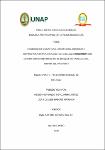Condiciones climáticas, vegetación, densidad y estructura etaria de Ranitomeya reticulata Boulenger 1883 (anura: Dendrobatidae) en el bosque de Varillal del CIEFOR, Iquitos-Perú

Date
2023Author
Taricuarima Pérez, Heisen Hernando
Raborg Arteaga, Jean Claude
Metadata
Show full item recordAbstract
From February to May 2022, in the varillal forest of the CIEFOR was evaluated climatics conditions, vegetation, density and age structure of Ranitomeya reticulata (ANURA: DENDROBATIDAE) by direct observation.The results indicate that the temperature of the undergrowth of the CIEFOR varillal forest during the day varied from 24 to 28.82 °C and the relative humidity between 80.6 (16 hours) and 98.6 % (18 hours).The species richness of plants was 217 species, with predminance of Fabaceae, Myristicaceae, Burseraceae, Lauraceae, Euphorbiaceae, Annonaceae, Meliaceae, Sapotaceae, Urticaceae, Apocynaceae, Elaeocarpaceae, Lecythidaceae and Moraceae. Ranitomeya reticulata in the varillal forest of CIEFOR was a bimodal density, with 37.33 ind/km2 in march and 22.50 ind/ km2 in april, and the age structure does not form of the broad-based pyramid. It is concluded that the climatics conditions (precipitation, temperature and relative humedity) in which the specie of Ranitomeya reticulata develops, in the CIEFOR varillal forest, are within the tolerance range favoring their presence in their different stages of development. De febrero a mayo de 2022, en el bosque de varillal del CIEFOR se evaluó las condiciones climáticas, vegetación, densidad y estructura etaria de Ranitomeya reticulata (ANURA: DENDROBATIDAE), mediante observación directa. Los resultados indican que la temperatura del sotobosque del bosque de varillal del CIEFOR durante el día varió de 24 a 28.82 °C y la humedad relativa entre 80.6 (16 horas) y 98.6 % (18 horas). La riqueza de plantas fue de 217 especies, con predominancia de Fabaceae, Myristicaceae, Burseraceae, Lauraceae, Euphorbiaceae, Annonaceae, Meliaceae, Sapotaceae, Urticaceae, Apocynaceae, Elaeocarpaceae, Lecythidaceae y Moraceae. Ranitomeya reticulata en el bosque de varillal del CIEFOR tuvo una densidad bimodal, con mayores picos de densidad en el mes de Marzo (37.33 ind./km2) y menores picos de densidad el mes de Abril (22.50 ind./km2) y la estructura etaria no forma la pirámide de ancha base. Se concluye que las condiciones climáticas (precipitación, temperatura y humedad relativa) en las que se desarrolla la especie Ranitomeya reticulata, en el bosque de varillal del CIEFOR, están dentro del rango de tolerancia favoreciendo su presencia en sus distintos estadíos de desarrollo.
Collections
- Tesis [419]

